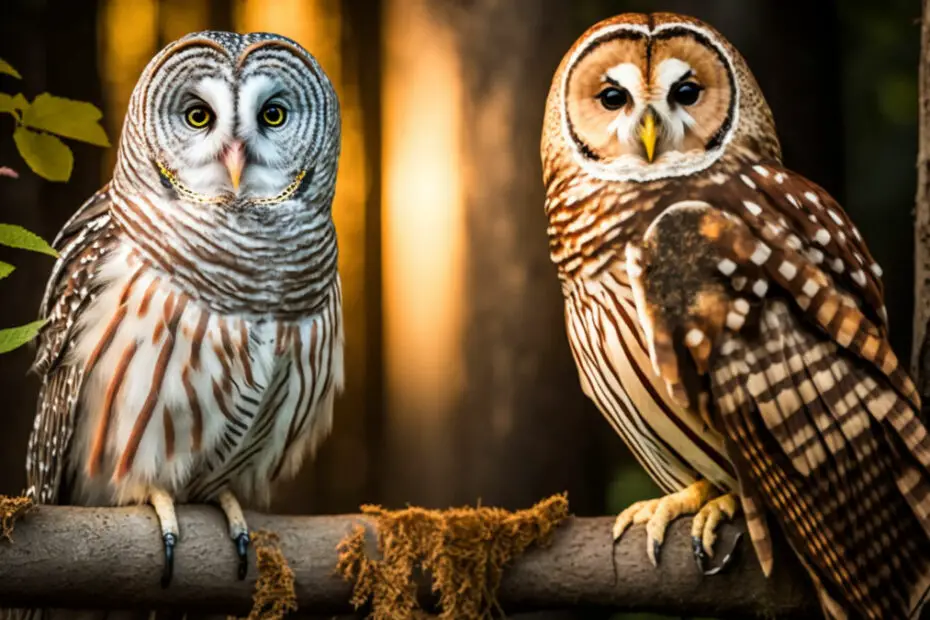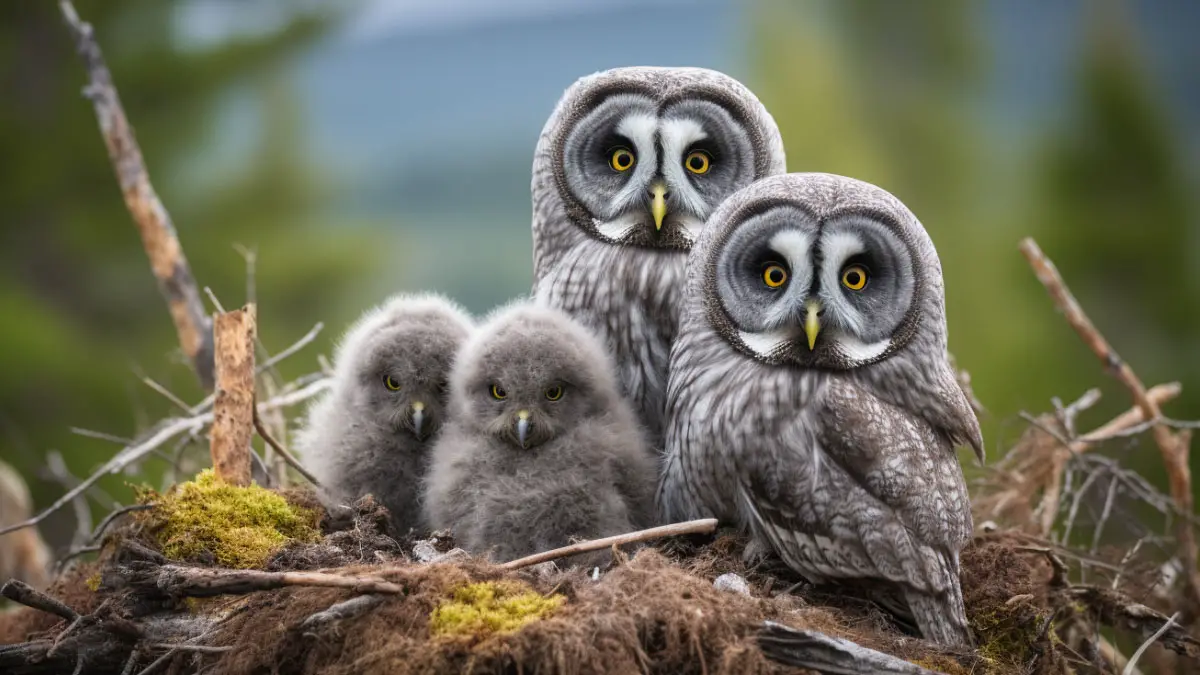From the appearance to vocalization and nesting behaviors, barn owls and barred owls can be distinguished.
When it comes to Barn Owl vs Barred Owl: identification, differences, similarities, you need to rely on multiple factors. Barn Owls can be identified by their distinct heart-shaped facial disks. And it is one of the most commonly found owl species. Barred Owls have a light gray plumage with brown bars almost all over their body.
But as there are similarities between the species, it can be confusing to identify them. In this article, we will discuss everything to distinguish these owl species. Let’s start with a quick comparison chart and get into more detail.
Barred Owl Vs Barn Owl: Comparison Chart

The following table will help you to distinguish both owls with differentiation in several features.
| Features | Barn Owl | Barred Owl |
| Species | Tyto alba | Strix varia |
| Feathers | Pale white | Light gray with dark brown bars |
| Facial Disk | Heart-shaped | Rounded |
| Eye Color | Black | Dark brown |
| Average Length | 25-45 cm | 43-61 cm |
| Average Wingspan | 75-110 cm | 99-111 cm |
| Weight | 550g | 715g |
| Expected Lifespan | 4 years | 18-23 years |
| Favorite Food | Small vertebrates, birds, insects | Small and medium mammals, birds, crayfish |

Barn Owl Vs Barred Owl Identification
Among two families of owls, Strigidae is known to be the typical or true owl. Barred owls fall into this family. The other family is Tytonidae, where the barn owls fall. So, there are a lot of differences in the appearance of these owls. The differences between them are as follows.

Size
Barn owls are quite small compared to barred owls. They have an average length of 25-45 cm, and females are a bit larger. The wingspan is quite large, though. Barn owls have an average wingspan of 75-110 cm. And their average weight is about 550g.
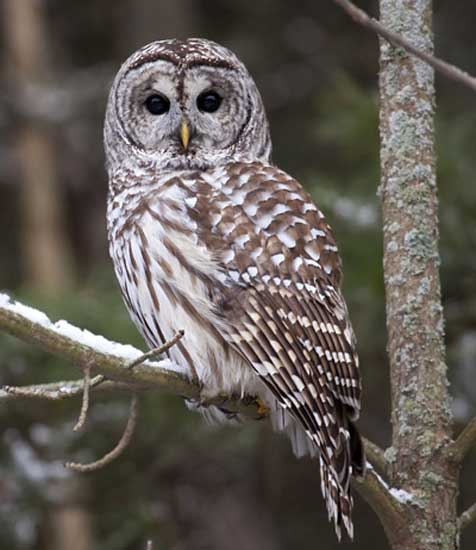
Barred owls are much larger, with an average length of 43-61 cm. And female barred owl size is similarly larger than male ones. Their wingspan covers 99-111 cm, which is quite large compared to many other owl species. And the average weight of barred owls is 715g.
Now that you know the barred owl size comparison, we will focus on the appearance of these owls.
Appearance
The plumage of barn owls is pale white, and you may see some slightly dark spots on their underbody. Wings usually have distinct patterns to identify barn owls from a distance. Their face is bright white, and the facial disk is quite different than other owls. This heart-shaped face is one of the easiest ways to identify a barn owl.
Though they don’t have many feathers like a Snowy owl, sometimes you can even see a reddish or grayish buff on their plumage. The eye color of barn owls is black. And the beak is mostly of light colors.

But barred owls are covered in light gray feathers with vertical dark brown spots. And this is why they are called barred owls. This species has an almost rounded head with round facial disks. Their eye color is dark brown, and there is a pale white X shape around their noses.
Their facial disk is grayish white, more like great grey owl, and the beak is yellowish. Ear tufts aren’t present in this species. The underbody of barred owls can be a bit different from the upper part. They have relatively shorter legs with buff-white feathers.
Barn Owl Vs Barred Owl: Feeding Behavior

As barn owls are a bit smaller, they prefer small prey, such as small rodents, other vertebrates, small birds, etc. They usually hunt from a low perch. It is also common for them to fly slowly at a low height and ambush small prey.
Barn owls are famous for feeding on rodents more than true owls. They can eat more than one small rodent, such as mice, or chipmunks, every night. Invertebrates are also in their diet as long as they have a mouthful. They also eat birds, termites, or crickets if available. But barn owls usually don’t eat domestic animals.
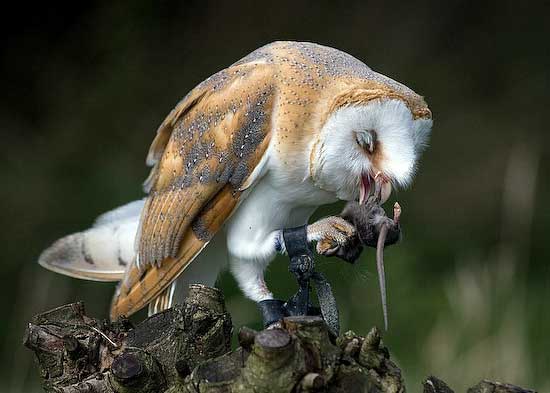
On the other hand, Florida barred owl, including other ones, eats a lot of things. Rodents are very common in their diet, including mice, weasels, squirrels, chipmunks, etc. Birds, lizards, snakes, and even turtles are also very favorite of barred owls. In fact, they might munch on a lot of things if available.
Crayfish and frogs are also their favorite. And they seem to hunt domestic animals like chicks. Barred owls also eat insects when there is a scarcity of food. The hunting time of these types of owls is usually at night or between dawn and dusk. But it can change depending on the necessity of food.

Barn Owl Vs Barred Owl: Nesting and Breeding
The breeding season of barn owls mostly depends on the amount of prey available. In warm-temperature regions, there is no specific breeding season. But it starts in March-April in the cold regions. Barn owls usually don’t make nests. They live in tree cavities, but building cavities are also seen to be their nesting sites.
These sites are usually 50-60 feet high. Barn owls tend to lay up to six eggs, and it takes a Florida barn owl 30-35 days to incubate the eggs. Hatchlings usually come out at the age of five to six weeks. At 8-10 weeks, they start seeking food on their own. Their breeding age is usually one year, but some owls may start breeding earlier.

On the other hand, the breeding age for barred owls is about two years. It can vary depending on how much food is available. These birds usually breed in late winter, and they stick to the same mating partner for their lives. Hooting and screeching are common to attract their partners.
Florida barred owl lays eggs in a nest built in broken snags or tree hollows. It isn’t also uncommon to see ground nests when the birds don’t find the right nesting site. They usually lay up to five eggs and the incubation period is about 28-33 days.
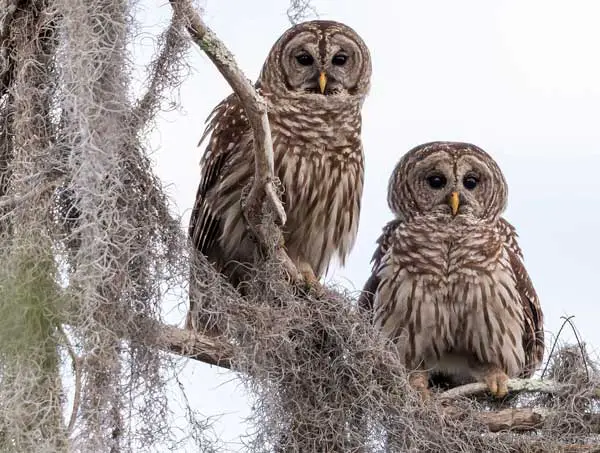
It takes the hatchlings about five weeks to leave the nest on their own. After one more week, the babies can fly and seek food independently. In some cases, barred owls may brood more than once in a breeding season if all of the babies are hunted by predators like Great Horned Owls.
Barn Owl Vs Barred Owl: Vocalization and Lifespan
Barn owls are less vocal than barred owls. They make a distinct screeching noise, which is quite different than the mellow noise of barred owl call. And they tend to live shorter in the wild due to predators. Captive barn owls may live longer. Whatever, the average life expectancy of these owls is about 4 years.

Barred owls, on the other hand, are pretty vocal. They produce a variety of sounds in different situations. Barred owl call includes hooting, whining, squealing, barking, or laughing. But the average lifespan of barred owls is much higher than barn owls. This species can live up to 23 years in captivity. But wild-barred owls live a few years less.
FAQs
To complement the discussion, here are answers to some frequently asked questions about barn owl vs barred owl.
Though the Florida barn owl is counted as endangered species in the US, the population of these owls isn’t that low in other ranges. So, it isn’t rare to see a barn owl. But as they are nocturnal, sighting one in the daytime may be rare.
These birds are nocturnal, meaning they will come out at night for hunting. But they are usually seen hunting at dawn and dusk. It isn’t impossible to see them hunting in the daytime if food is scarce or the weather is bad. Like the great grey owl, they can camouflage with the environment.
No, they are nowhere near friendly. In fact, they are quite territorial, meaning they will start hooting or even striking intruders to save their nests, partners, and baby owls.
Conclusion
Even the most experienced birdwatchers sometimes struggle to identify an owl species correctly as owls have a lot of species and variations. But barn owl vs barred owl: identification, differences, similarities, is relatively easy due to the distinct differences in their appearance. From the color of the feathers to the shape of the facial disk, everything is quite different in each species.
We noted as many characteristics as possible so that you can easily identify these species. Though sighting these owls isn’t common at all times, distinguishing one from another may give you immense satisfaction.
